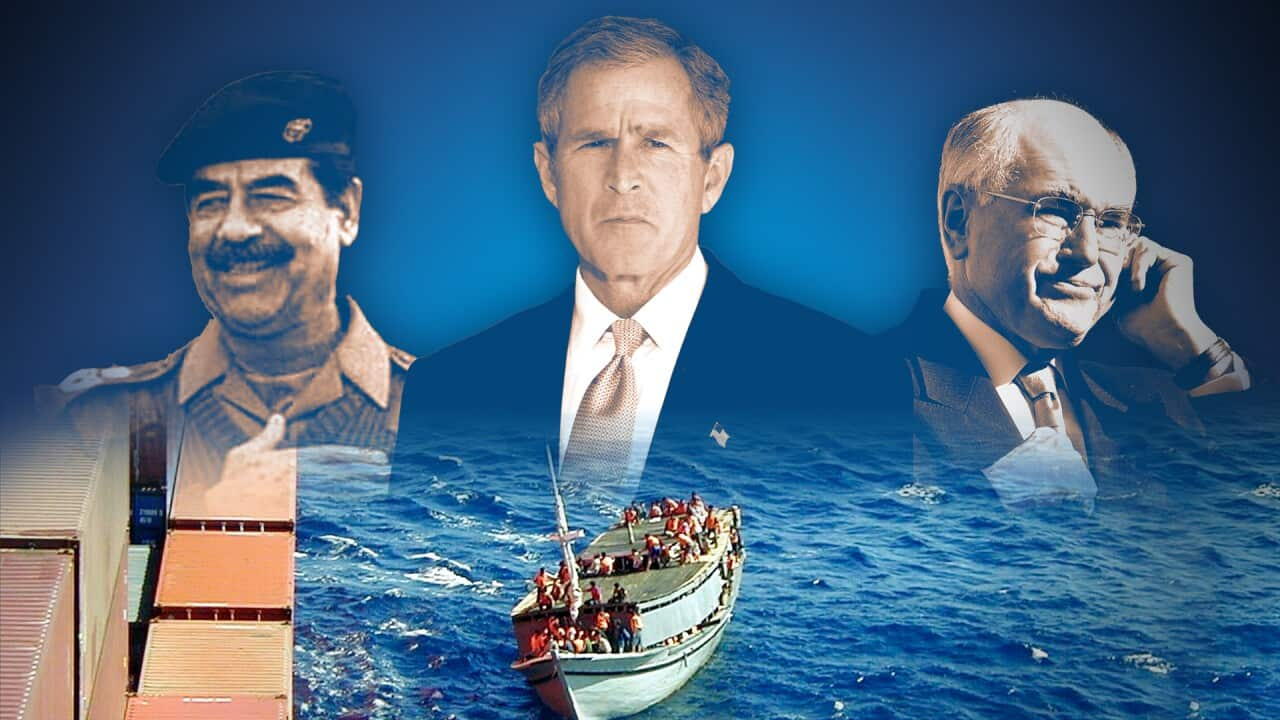KEY POINTS:
- Months after the invasion of Iraq, John Howard's cabinet discussed how to return refugees fleeing the conflict.
- Cabinet papers show the government considered when Iraqi authorities could be capable of receiving them.
- At the time, Iraq was on the brink of a full-blown civil war and the bloodshed would not peak for years.
Just months after joining the invasion of Iraq, and with the country descending into full-blown chaos, the Howard government discussed how refugees created by the conflict could be sent back "voluntarily or involuntarily".
The revelation is one of a number from the 2003 cabinet papers, released after 20 years, giving limited insight into the motivations of former prime minister John Howard as he took Australia to war.
But the defence minister at the time, Robert Hill, has conceded there was little reason to be optimistic about a stable Iraqi government capable of processing the return of refugees in the short or medium term.

The documents provide limited insight into what motivated former prime minister John Howard (right) to join the invasion of Iraq, spearheaded by the US and its president at the time, George W. Bush (left). Credit: Getty
But they do show that in June 2003, with Iraq on the brink of a full-blown civil war, Howard's cabinet was already discussing how Iraqi refugees fleeing to Australia could be sent back in the future, whether they wanted to return or not.
Australia had committed troops to an American and British combined force in March 2003, with Howard joining then US president George Bush and UK prime minister Tony Blair in claiming the Iraqi dictator Saddam Hussein possessed weapons of mass destruction.
That claim was later found to be incorrect, though Howard maintains the invasion was the right decision based on the intelligence at the time.

Civilian deaths in Iraq peaked years after the meeting. Source: Getty, AFP / Odd Andersen
While acknowledging "ongoing security concerns" in Iraq in June, the cabinet considered whether "stable" Iraqi authorities would soon be able and willing to accept those who had fled the war.
"It is likely that the new governance arrangements will progressively open up opportunities to resolve the situation of Iraqi asylum seekers temporarily in Australia," a record of the cabinet meeting said.
Australia, therefore, needs to have arrangements in place to allow for the voluntary and, when appropriate, involuntary return of Iraqis when prevailing security conditions permit.Cabinet meeting record
Cabinet would also "consider exploring" the provision of "modest technical assistance" to Iraqi authorities to aid the process.
A hardline stance on immigration, including a ramp-up in , was a key component of Howard's electoral success. His decision to deploy SAS troops to prevent the Tampa, a Norwegian vessel that had rescued 433 refugees, from reaching Christmas Island in the lead-up to the 2001 election is considered a major factor in his victory.
Iraq's embassy in Australia was closed in 2003 but was reopened the following year under the interim Iraqi government.

Howard's hardline approach on immigration, including the Tampa affair, was already central to his political image by 2023. Source: AAP / Dita Alangkara
Deaths in Iraq would not peak for years
The cabinet meeting on Iraqi refugees was held just weeks after Bush declared "mission accomplished" in Iraq.
"Major combat operations in Iraq have ended. In the battle of Iraq, the United States and our allies have prevailed. Now, our coalition is engaged in securing and reconstructing that country," he said.
The optimism proved misguided.

The cabinet meeting on Iraqi refugees was held just weeks after then US president George W. Bush declared "mission accomplished" in Iraq.
Hill said he did not specifically remember discussions about returning refugees, but accepted there were few reasons to be optimistic about stability in June 2003.
"By three months after (the invasion), it was getting bogged down and there was going to be no easy path to stability and predictability in Iraq," he said.
"The CPA (Coalition Provisional Authority) was busy dismantling the institutions of Iraq, so that automatically means a vacuum."
The bloodshed would not reach its high point for another three years, with civilian deaths peaking in 2006 and 2007.
In 2006 alone, the estimated more than 29,500 civilians were killed in the country.
Howard would govern until the end of the next year.
The US-run transitional government — the CPA — had already disbanded the Iraqi army and intelligence services, a decision which rendered roughly half a million armed men unemployed virtually overnight.
Rather than helping to stop an insurgency, many actively joined it.

The disbanding of the Iraqi army, months before the meeting, helped propel an insurgency, which would later mutate into the self-proclaimed Islamic State group.
"I can’t remember. I'm sure I said: 'This is the policy, what happened?'” he said.
A key retired army chief later described the disbanding of the army as a "huge strategic mistake" that allowed the insurgency to grow.
Many former military and intelligence officials sacked at the time went on to play central roles in the self-proclaimed Islamic State group, which brutally governed swathes of Iraq and Syria it seized between 2013 and 2014.









